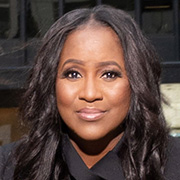
Nadine Spencer
CEO, President
Education: BA Hon, York University
Company Name: BrandEQ Agency
Industry: Marketing Communications, Equity
Company CEO: Nadine Spencer
Company Headquarters Location: Toronto, ON
Number of Employees: 17
Words you live by: Show up! Life is about showing up, this is when opportunity presents itself.
Who is your personal hero? My Mom, Eva Hunter
What book are you reading? The Promised Land by Barack Obama
What was your first job? Bakery entrepreneur at the age of 12
Favorite charity: The Black Business and Professional Association
Interests: Antiquing, all things creative, and chess critical thinking
Family: Daughters, Jeaneva and Danielle; Nana to 1-year-old Nola
Cultural Blind Spots Can Lead to Brand Disaster
As we approach the end of a year in which many have become “woke” about the racial issues in America, Canada, and around the world, I feel compelled to address the lack of equity at the top in my marketing profession. Simply put, I believe that a more diverse group of decision makers can help brands achieve success in multicultural marketing.
Brands often fumble when it comes to race, whether by telegraphing multiculturalism in inauthentic ways or releasing messaging that’s downright offensive. Dove fell into the latter category with a controversial ad that had consumers outraged. It showed various women peeling off their sweaters to reveal the next woman, including a Black woman peeling off to reveal a White woman. This ad reinforced an established soap advertising message that Black is dirty and White is pure and clean. Dove likely intended for this ad to be inclusive so that its body wash would appeal to all women, but this seemingly innocuous oversight ignited a firestorm of criticism.
Similar controversies ensued when H&M ran a campaign showing a young Black boy in a hoodie that read “Coolest Monkey In The Jungle,” and when Gucci released a black turtleneck “blackface” sweater, showing a big mouth with red lips. These gaffes unknowingly perpetuated hurtful, racist caricatures, and it was truly astounding that these products and campaigns gained approval without any objections.
If people of color had a seat at the table in these organizations, these international PR disasters would likely have been avoided. It’s in events like these that the value of diversity is learned the hard way. After all, a cultural blind spot in multicultural marketing can lead to the downfall of a brand.
Insensitive and unintentionally racist messaging isn’t limited to the fashion and beauty sectors. The lack of representation extends to boardrooms across all categories. This lack of diversity explains why missteps in organizations’ marketing continue to happen. Brands are advertising to diverse audiences, but they don’t have diverse teams that can create empathetic, authentic, and informed messaging.
One of the greatest benefits of diversity is the ability to connect with and understand different parts of your customer base. Bringing people from all walks of life into the boardroom can help brands craft and launch more effective campaigns, increasing revenues and fortifying their cultural awareness in the process.
Multicultural marketing is important, but it has to be done correctly. You can’t just throw Black people into an ad without first understanding the Black experience. Your decision makers must be truly representative of the diverse population you’re trying to connect with. Multicultural marketing can help brands expand their reach, but only if it’s done well. And diversity is the first step.






